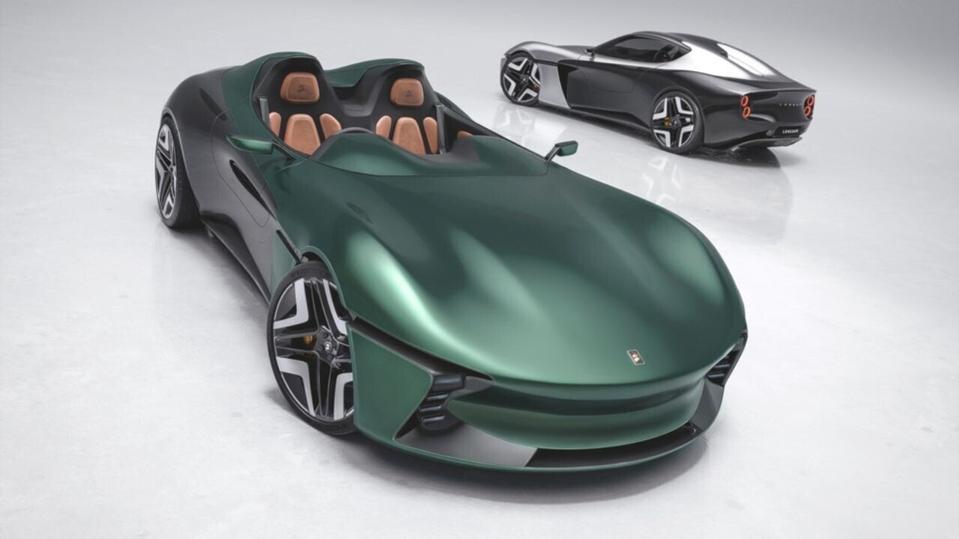British automakers like Lotus are known for engineering sleek sportscars with ultra-low curb weights that enable brisk acceleration from engines that would otherwise be considered tepid in larger and heavier rides. As an example, the classic Lotus Elise – upon which the original Tesla Roadster was based – packed a Toyota-derived 1.8-liter four-cylinder engine that generated what would seem to be a puny 188 horsepower and 133 pound-feet of torque, yet its super-slim mass (around one ton) enabled it to register a 0-to-60 mph time at under five seconds, which was decidedly brisk for its time.
Both Elise and Tesla’s initial production models are long gone, and while a new Tesla Roadster has been planned (and delayed) for several years now, a fledgling U.K. brand named Longbow Motors, hopes to beat Elon Musk to market next year with a pair of what it calls the world’s first “FEVs” (for Featherweight Electric Vehicles).
Founded by veteran British engineers Daniel Davy and Mark Tapscott, both with sportscar and EV development on their resumes, the company’s motto is “Celeritas Levitas,” which is Latin for “the speed of lightness.”
The brand’s premiere offerings, planned for introduction in 2026, will be a pair of low-slung two-seat rear-wheel-drive EVs, the Longbow Speedster and Roadster. Each is wrapped in graceful exterior lines and curves that sweep rearward from a massive hood that evokes a classic Jaguar XKE from the 1960’s. The Speedster comes without either a windshield or a roof, however, for the ultimate open-air experience.
Rather than engineer and develop each of the cars’ major components in house, including the batteries, motors and brakes, they’ll reportedly be sourced from established Chinese suppliers to hold down costs and speed development. Each model will come powered by a 240 kw electric motor (at an estimated 322 British horsepower) and over 2,000 nickel-cadmium battery cells. Range on a charge is anticipated at a European-rated 275 miles (443 km) for the Speedster and five additional miles on a charge for the Roadster We’d guess dual-motor all-wheel drive models could arrive at some point in the vehicles’ future.
While the Longbows’ outputs pale compared to some of the most powerful EVs on the market, either promises a 0-62 mph time at around 3.5 seconds, which places them firmly in supercar territory, thanks to extensive use of lightweight aluminum and composite components. Their curb weights are planned to tip the scales at around a svelte 2,000 pounds, which itself is about the weight of a Ford F-150 Lightning EV’s battery pack alone.
Both premiere models are planned for a limited production run of 1,500 units, and the company promises to show a prototype of the Speedster by midyear, with a production model scheduled for 2026, to be followed in subsequent months by the Roadster.
Best of all, while the Longbow FEVs are built to run with Ferraris and Lamborghinis, they’re planned to be more affordable alternatives. The Speedster is expected to start at $109,900 (£84,995), with the Roadster commanding a less-costly $84,040 (£64,995) base price.
High rollers can step up to an even more-limited Luminary 1st Edition of the Speedster with 10 units planned, or the Autograph Edition of which 25 are said to be produced. There will also be 50 Luminary 1st Edition Roadster units up for grabs as well as 100 Autograph Edition versions. No word yet how much of a premium those limited models will command.
Specifics including standard and optional equipment, U.S.-certified specs and availability on this side of the Atlantic are yet to surface.
Oh, in case you haven’t yet caught on, the Roadster’s moniker was reportedly chosen as a dig at Tesla’s yet-to-surface second-generation model of the same name.
“A lot of customers have put deposits down for a Roadster that they can’t get,” says co-founder Daniel Davy via Top Gear. “If people want to get back their $250,000 deposit for a 2020 car and put it into a better car, they’re going to get one sooner (and) they’re welcome to do it.”

